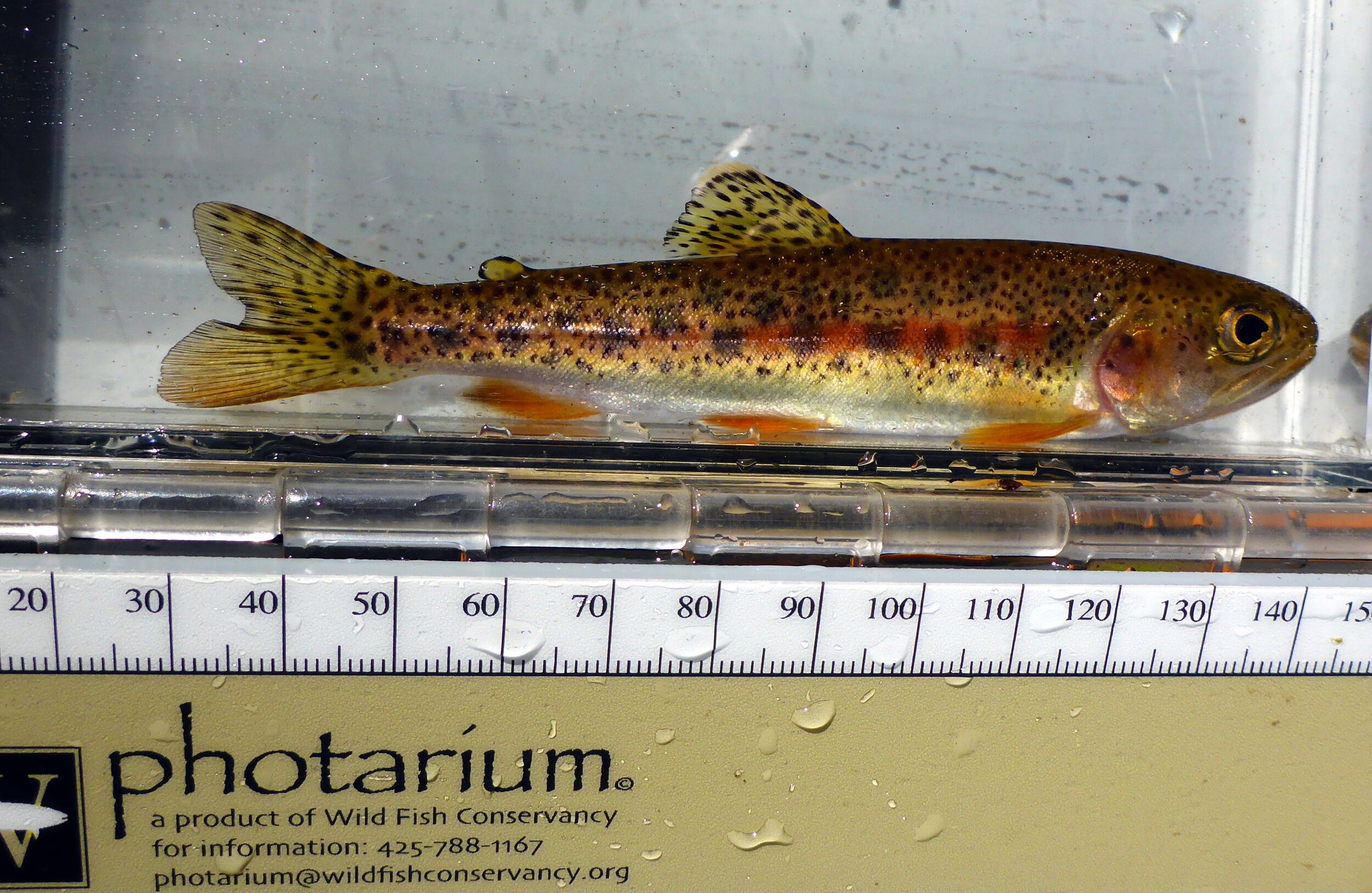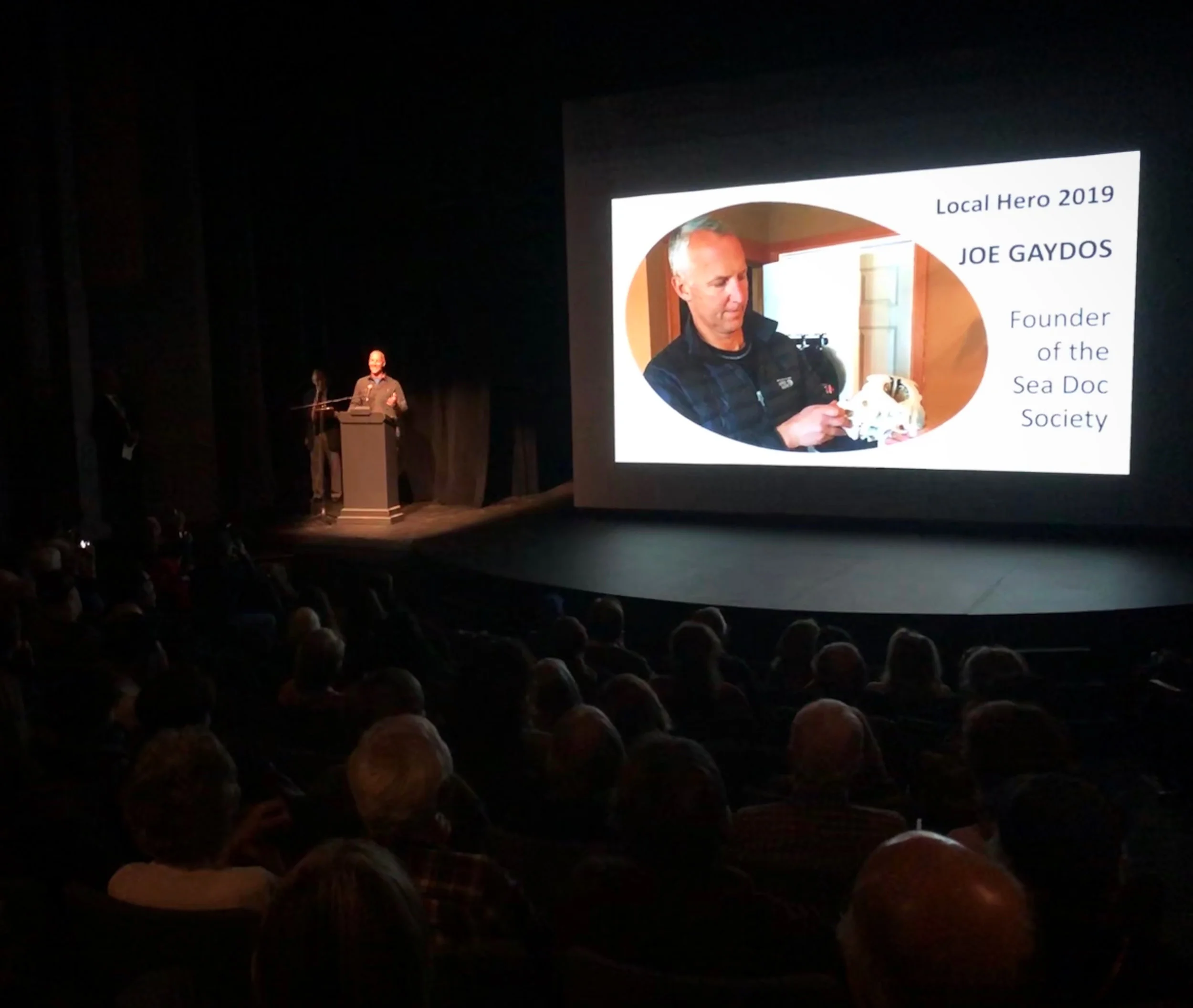Only 5% of Washingtonians and 14% of British Columbians know what the Salish Sea is. So we did what any good scientific organization would do and hit the streets of Seattle while wearing a killer whale costume to see if they know the name of the sea right in their backyard. Could they help our orca find the Salish Sea?
Cutthroats Surviving Upstream Against All Odds
Locals throughout the Salish Sea have long told stories of coastal cutthroat trout, with their distinctive blood-red slashes at the base of their jaws, flourishing right here in our streams. That’s far from the case now, but it was enough evidence for SeaDoc to fund a unique collaboration of scientists to scout the small streams of the San Juan Islands for these native “cutts,” the least-studied of all local salmonid species.
That team of scientists from Wild Fish Conservancy, Long Live the Kings, Speckled Trout Consulting, Kwiaht, and Washington Department of Fish and Wildlife recently published their findings in Conservation Genetics. You can read it in full here: Genetic composition and conservation status of coastal cutthroat trout (Oncorhynchus clarki clarki) in the San Juan Islands, Washington. The paper was written by Jamie Glasgow, Jennifer D. De Groot, and Maureen P. Small.
Giving Thanks for Bill Ruckelshaus
I was saddened to hear of the passing of Bill Ruckelshaus, first and fifth head of the U.S. Environmental Protection Agency, Deputy Attorney General of the U.S., acting Director of the FBI, a Member of the U.S. Commission on Ocean Policy, founding Chair of the Puget Sound Partnership and the recipient of the highest civilian honor, the Presidential Medal of Freedom. He served four Presidents and three Governors and was mentor and friend to both me and the SeaDoc Society.
I first met Bill when he played an instrumental role in setting up Washington’s Puget Sound Partnership under Governor Gregoire. Over the years, I was so impressed that a person of his stature and intellect always graciously took time to answer my questions and guide be on policy and process needed to improve the health of the Salish Sea for the benefit of people, wildlife and our economy.
Salish Sea Wild: The Salish Sea’s Greatest Spectacle
Team SeaDoc witnesses the Pacific Northwest’s most awesome wildlife spectacle as more than 100 million spawning herring lure the greatest annual gathering of Salish Sea predators to the Strait of Georgia. Join us for front-row seats above and below the water as thousands of marine mammals and seabirds, hundreds of hungry raptors, and packs of killer whales assemble for the feast.
Farewell to SeaDoc Regional Director Markus Naugle
Since 2016, The SeaDoc Society has grown its impact and reach, expanding not only our scientific capacity but also launching our youth education program and accelerating outreach efforts. This heady time for SeaDoc has been led by Regional Director Markus Naugle.
This month, Markus announced his resignation as Regional Director from SeaDoc Society due to recent changes in his father’s health that require Markus’ help. Please join us in wishing Markus and his family all the best in this time of need.
Heavy Metals in Harbor Seals of the San Juan Islands
Toxins of concern in the Salish Sea include persistent organic pollutants (like PCBs), hydrocarbons (from fuel), pharmaceutical compounds, and trace elements (including heavy metals).
Some elements (like copper, selenium, and calcium) are necessary for life at lower concentrations but can be toxic at higher levels. Other elements considered non-essential (like lead and mercury) also can be toxic to aquatic organisms at elevated concentrations. Monitoring trace element exposure in marine organisms is essential to assess potential risks to wildlife and humans.
Joe Gaydos Receives Local Hero Award at Friday Harbor Film Festival
SeaDoc Society Science Director Joe Gaydos received the Local Hero award at the Friday Harbor Film Festival over the weekend for his work with the SeaDoc Society and his involvement in the San Juan Islands community. He took a moment to thank the local supporters who have made SeaDoc’s work possible. For those who weren’t able to attend, we offer Joe’s thanks in this post.
Salish Sea Wild: The Scoop on Southern Resident Killer Whales
In this episode, Team SeaDoc works with scientists trying to save the Salish Sea’s most iconic and endangered species: the Southern Resident killer whale. The goal is to collect critical health and diet data from each of the 73 surviving animals. So how does a wildlife veterinarian make a house call to do non-invasive medical tests on 10-ton killer whales in the open sea? It takes sharp eyes and a fine mesh net.
Ocean Night: Winter 2019-2020 Schedule
Ocean Night is back for another awesome season at the Sea View Theatre! See you there!
Browse the schedule and join us for a free night of family-friendly science. We’ll keep the theatre nice and warm, so don’t let the cool weather and the early nights keep you at home. Ocean Night is a perfect opportunity to engage with the community during the down season.
Plastic Packing Strap Removed From Sea Lion's Neck
The SeaDoc Society joined forced with the Vancouver Aquarium marine mammal rescue staff and officers from Fisheries and Oceans Canada (DFO) last week at Race Rocks Ecological Reserve, a marine protected area near Sooke, on Vancouver Island. The teams were responding to reports of at least one Steller sea lion and one California sea lion seen entangled in plastic.
On arrival by DFO boat to Race Rocks, and with the help of the Race Rocks Eco-Guardians, teams were able to spot a male Steller sea lion, weighing more than 1,000 pounds, with a plastic packing band wrapped tightly around its neck. The depth and severity of the wound indicated that the plastic had been there for some time.
Photos: REEF Divers Count Species Around Hornby Island
This year REEF and SeaDoc Society’s Advanced Assessment Team was deployed at Hornby Island in British Columbia. The team spent a week doing REEF surveys of fish and invertebrates at the wonderful dive sites around Hornby Island in the Care of Hornby Island Diving. Visibility was quite good for most of the dive sites, reaching 60 feet a couple times. The Team did 10 dives at different sites and also added in a few dives right in front of the resort. This video by Ed Gullickson is just a few of the highlights of this effort.
Returning: Joe Gaydos on What Makes the Salish Sea Special
The Salish Sea is a great example of a beautiful place where people and the natural world are dependent on one another. In scenic locales like protected national parks, people are not so much participating in nature as they are observing it. In the Salish Sea people are fishing, heating their homes with firewood, and more.
In this short segment is a “b-side” for the mini feature film, Returning. In the clip, SeaDoc Society Science Director Joe Gaydos reflects on what makes this ecosystem special.
Joe Gaydos to be Honored as Local Hero
Our Science Director, Joe Gaydos, will be honored with the Local Hero Award at the Friday Harbor Film Festival on San Juan Island this fall! The award will be presented at 7pm on October 27th, the final night of the festival. If you’re interested in attending the event, which takes place at the Whittier Theatre at the San Juan Community Theatre, check out their website for ticket information.
Relocating a Stranded Harbor Seal Pup
Jump on board the Nancy Bee as we relocate a stranded harbor seal pup from San Juan to Yellow Island, where adult seals regularly haul out. Not all pups can be expected to survive pupping season, but this gives little Z8 a chance... This work is done in conjunction with the Marine Mammal Stranding Network and The Whale Museum.
What the Loss of 3 Southern Resident Killer Whales Means
In early August, three Southern Resident killer whales were declared dead by the Center for Whale Research. That brings the population down to just 73. Each of the dead whales are from separate Southern Resident pods.
“There is nothing good about losing three animals in a population that was numbered at 76,” said SeaDoc Science Director Joe Gaydos. “In no way can I find a silver lining to this news.”
Deep Green Wilderness Sets Sail to Find the Rarest Whale in the World
A local crew of sailors and marine scientists are leaving on an expedition this week to look for the rarest whale in the world, the North Pacific right whale.
The expedition will be led by Kevin Campion, founder of marine education nonprofit Deep Green Wilderness and member of SeaDoc Society’s Board of Directors. Campion and a crew of four are setting sail out of Dutch Harbor, Alaska on Wednesday, August 14, en route to the Bering Sea to continue their search for the rare whale.
Photos from the 2019 Wine & Sea Auction
Responding to a Seal Pup Stranding With SeaDoc Intern Lizzy Ashley (VIDEO)
Beneath Pacific Tides: Subtidal Invertebrates of the West Coast (Book Review)
Team SeaDoc Does the Salish Splash! (VIDEO)
The Salish Splash is an annual event that brings awareness to the Salish Sea and its many species. Our Science Director Joe Gaydos was challenged by Mindy Roberts of the Washington Environmental Council. After doing a backflip for this event last year, Joe wanted to take it up a notch, so he invited all of Team SeaDoc to join him for an even bigger splash! What better way to show your support and enthusiasm for orca recovery and Salish Sea health than by jumping for joy into the water?
















